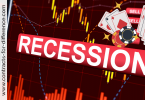The appearance of the candlestick body and its shadows provide a lot of information about the state of the market and where it’s going.
The length of the candlestick body shows where the majority of the trading took place. A long body suggests that the market is trading heavily in one direction, while a small body indicates lighter trading.
In our examples, you’ll notice that green candlesticks appear in an ‘up’ candle; in other words, the currency closed higher than the previous candle’s close. Red candlesticks show a “down” candle or that the currency closed below the previous candle’s open.
Traditionally, up trends were represented by white candlesticks, while down trends were depicted by black candlesticks. Today, traders can normally select any color combination they want. For our purposes, we’ll continue to use the green and red colors to show ups and downs.
Identifying Candlesticks Patterns
Being able to read the candlesticks in a candlestick chart can help you see the current state and direction of the market. This can help you make decisions about the market now, but how about what the market will do in the future?
Candlestick charts can also display specific bullish (strengthening) and bearish (weakening) patterns that cannot be seen on other charts. These can help you find potential market opportunities and make decisions about what to do in the future. Let’s look at a few patterns that may help you.
Doji
The Doji often marks the end of a trend. It is the candlestick that has virtually no body, which means that the opening price was very nearly the closing price, which implies that the market may be undecided where the price is going. It’s a danger signal, as well as an opportunity to find a change in direction.
On its own, the doji can’t tell you much about the market trend. It’s neutral, and gets more meaning when you consider the surrounding candles. However, the length of the shadows does have some meaning, which I will cover later.
Engulfing
The engulfing pattern is exhibited by two opposite colour candles, where the body of the second one ‘engulfs’ the first body. For instance, a small white (bullish) body may be engulfed on the next day by a black (bearish) candle, where the open (top of body) is higher than the previous close (which was also top of body, on the bullish candle), and the close is lower than the previous open. There is no or little ‘wick’ above or ‘tail’ below. This is a bearish engulfing pattern. A bullish engulfing signal is the opposite, when the day starts out low, and the close is high, giving a candle that engulfs the body of the previous day and showing that the bulls are winning.
Shooting Star
This quite often happens near the top of a upward trend. It is a small body, with a long ‘wick’, or upper shadow. What it shows is that higher prices were tried during the day, but none of them stuck, which suggests that the bullish run is getting tired. There are several other candlestick formations that are called ‘star’ patterns, and they are all powerful reversal signals. To qualify to be called a star, the pattern appears at the top or bottom of a trend, and is a small or Doji candle gapping above (below) the previous, followed by a reversal candle closing well into the previous real body.
Hanging Man / Hammer
Hanging Man and Hammer are very similar in shape, having a short body at the top of the shadow – and a ‘shaven head’. The body can actually be either colour, but should be less than half the length of the tail. The hammer can appear at the bottom of a downtrend, and may signal time to hammer the price back up – the bears failed to make the intraday lower prices stick at the close. The hanging man appears after a rising trend, and often signals that the trend is stalled, and you should probably take your profits. This is an example of how the surrounding candles can make a difference to how you interpret the signals, the same shape is interpreted as either the Hanging Man or the Hammer, with totally opposite meanings.
There are many more named candlestick patterns, and it’s worth getting to know the main ones, but the meanings flow from consideration of what they represent, as demonstrated above.







